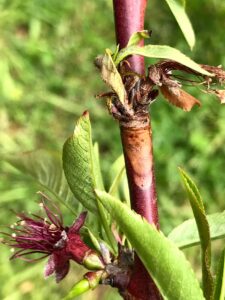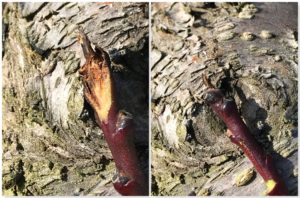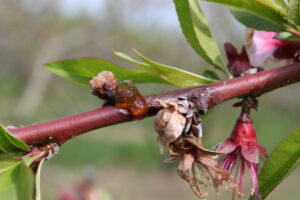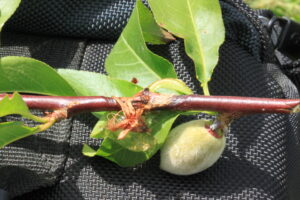Tree Fruit Phenology:
Tree fruit phenology is advanced in southern counties based on historical observations. In southern counties some early blooming varieties are 50% bloom. Redhaven was at pink on March 25, about 11 days earlier than the median observation date. Red Delicious was at ¼” green tip on March 18, about 14 days earlier than the median observation date. Some apples are at ½” green tip, and pears are about green cluster to white bud. Plums are full bloom. Cooler weather has slowed development.
Peach:
Brown Rot: Blossom infections from the brown rot fungus can occur whenever pistils are exposed and a favorable climate exists. Infections can occur during any wetting period when temperatures are between 41 and 86 °F. However, optimum conditions for infection occur with wetting and temperatures in the mid 70’s. During long wetting periods (several days or more) blossoms can be infected regardless of temperature. Generally infections that occur when conditions are sub optimal are less severe. Blossoms and fruitlets will remain susceptible until the pistil dessicates (sometime between petal fall and shuck split). Initiate coverage for blossom blight starting at pink for short petaled varieties and 5-10% bloom for showy flowers. See the NJ Commercial Tree Fruit Production Guide for recommended materials and rates.
Bloom Cankers: Bacterial Spot is a key pest of Peach, Nectarine and Plum and in some years can cause significant losses. It is caused by the bacterium Xanthomonas arbicola pv. pruni. Black tip cankers caused by bacterial spot usually appear during or just after bloom. Typical symptoms are a gradual blackening of the tip with dead tissue moving down the twig and is often observed on highly susceptible cultivars (Fig. 1). Tip die back may also occur from abiotic factors such as frost. Tip die back from frost is often accompanied by blind wood usually 6-8 inches below the tip where leaves and flowers have fallen off after being killed by a freeze. Spring cankers that are caused by bacterial spot may also form around flower buds and may be confused with constriction canker or brown rot (see below) Spring cankers are not commonly observed in our region.
In some cases the twig may appear healthy and a shoot begins growing from the tip only to die back after leafing out and flowering. This is often a symptom of fall infections of leaf scars by constriction canker. Many times a bud that was infected in the fall and never leafed out may be found just below the new shoot that is dying (Fig. 2a). Mild gummosis around the dead bud may also be observed. These symptoms may be more prevalent in old trees that have a history of the disease. Growing tips may also be killed if the leaf scar was infected and may be confused with black tip from bacterial spot.
Another disease that causes cankers on flower buds is Monolinia fructicola, the cause of brown rot blossom blight. During bloom flowers that are infected by the brown rot fungus will rapidly dessicate and form a canker around the bud similar to late winter or early spring infections by constriction canker (Fig 2b.). These can be distinguished from blossom blight by waiting a few days to see if the brown rot sporulation appears on the canker. Symptoms of brown rot also differ from constriction canker in that excessive gummosis will appear at the canker site (Fig. 3).

Fig. 2b. Early onset symptom of late winter/early spring infection by constriction canker. (photo D. Schmitt)
Oriental Fruit Moth: A biofix point for OFM has not yet been set. OFM biofix is defined as the first sustained trap captures (2 or more consecutive days of trap captures of more than one adult.) It usually coincides with full bloom (about 4/13 in southern counties) but can start as early as late March. The first insecticides for first generation Oriental Fruit Moth control should be applied at 170-200 degree days (base 45 deg F) after biofix. This timing generally coincides with petal fall in peaches. Timings can be calculated using the degree day calculator at the NEWA website by choosing the weather station nearest your farm, entering the biofix date as the start date, and choosing base 45 in the “degree day type” menu. Mating disruption may be substituted for insecticide applications by placing dispensers or initiating sprayable formulations of pheromone in the orchard anytime before biofix. See the NJ Commercial Tree Fruit Production Guide for more information.
Green Peach Aphid: GPA colonies begin forming sometime during bloom. Examine trees for the presence of colonies from pink to shuck split. Count the number of colonies on ten trees and use a treatment threshold of 2 colonies/tree at petal fall for peach, and 1 colony/tree for nectarine. The best way to scout for aphids during bloom is with a beating tray. Blossoms may also be collected, opened, and examined for the presence of aphids using a hand lens. See the NJ Commercial Tree Fruit Production Guide for recommended materials and rates.
Tarnished Plant Bugs and Other Catfacing Insects: Catfacing insects cause little damage at this time of the year. Catfacing insects will become more of an issue as temperatures warm and mowing and other ground cover activities become more common after bloom. Insecticides for catfacing insects are not recommended until after all petals are off.
Scale Insects: Oil applications may be safely applied up to pink on peach. Other options include Centaur, Sivanto Prime, Esteem, and Venerate. These products can be combined with oil or applied alone. See the apple section below for more information.
Apple:
Diseases: Fire blight is the main target at this stage. Copper formulations applied for fire blight suppression should be adequate for scab control at green tip to 1/4″ green, unless scab was not controlled in 2022. If your orchard had scab last year, include a protectant such as vangard or syllit at 1/4″ green tip. Copper should not be applied after 1/4″ green where fruit russet is a concern. Beginning at 1/2″ green highly effective scab materials should be used. Primary apple scab spores are released during any substantial infection period. At tight cluster include products effective for powdery mildew and cedar apple rust. See the NJ Commercial Tree Fruit Production Guide for recommended materials and rates.
Scale and Rosy Apple Aphid: One sees many recommendations for mixing materials efficacious for scale such as the insect growth regulators (Centaur; Esteem) with delayed dormant oil applications. The general consensus from data review seems to be that the addition of scale insecticides to oil do not significantly improve control over oil applied alone. Recent tests performed by Dr. Neilsen’s lab indicate that Sivanto Prime, Centaur and Venerate when applied alone in the pre-bloom period are comparable to dormant oil for scale control. Esteem has good efficacy for scale when applied up to to 1/2″ green. Closer has some efficacy against scale, however it has not been evaluated for control of overwintering scale. Esteem, Closer, Sivanto Prime, and a new product: Versys, applied either alone or with oil at 1/4″ to 1/2″ green all have good to excellent ratings for rosy apple aphids. See the NJ Commercial Tree Fruit Production Guide for more information. Note that the Virginia Spray Bulletin for Commercial Tree Fruit Growers lists syllit as incompatible with centaur.
European Red Mite; San Jose Scale: Oil applications for mite suppression and scale control should start at 1/4” green. Apply 2% dilute or 4-6 gals oil/acre concentrate at 1/4”green to tight cluster; 1% dilute or 2-3 gals/acre concentrate at tight cluster to pink. Oil should not be applied if temperatures are expected to dip into the mid 30’s within 48 hours of application, and captan or sulfur should not be applied within 14 days of any applications of oil or oil based formulations. Check the product labels for additional phytoxicity precautions.
Pear:
Pear Psylla: Dormant oil applications should have already been started to deter psylla egg laying. At the green cluster stage a pyrethroid is generally included with oil to knock down adults migrating into the orchard. In lieu of oil, Surround may also be applied starting at swollen bud and continued through bloom. If using Esteem for psylla control make one application delayed dormant through popcorn or two applications; one at delayed dormant through popcorn and one at petal fall. Centaur is also effective and one application may be made pre-bloom or at petal fall. Sivanto Prime is also labeled for early season applications and should be combined with oil.
Pear Diseases: Copper for fire blight suppression should not be applied past the green tip stage if fruit russet is a concern. Include effective materials such as Ziram or EBDC formulations for Pear Scab and beginning at the cluster bud stage. At white bud use products effective for rust, pear scab, and fabrea leaf spot. Particular attention should be paid to rust on asian varieties. Start planning for blossom sprays using antibiotics. For both apples and pears, consider using Kasumin at bloom. Kasumin is an antibiotic like Streptomycin and Oxytetratracycline. It contains Kasugamycin which is a different chemistry. Kasumin is only labeled for bloom and petal fall applications while strep and oxytet are labeled for post bloom use. Using 3 different chemistries in rotation allows for resistance management while extending the protection into the post bloom period when late blossoms typically appear. Whichever material you use, the addition of Actigard, Lifeguard or other plant defense elicitors during bloom may improve control.



